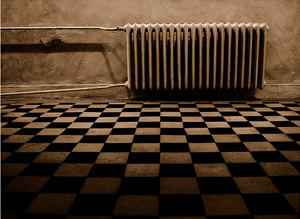
Home heating costs in the Northeast and many parts of America are often the largest slice of annual energy costs….who out there is not afraid to open the utility bill this season? 33% of US homes use hot water or steam radiant heating systems but very few know how to operate this system effectively. The good news is that most radiator systems have simple opportunities for large efficiency increases, saving the homeowner hundreds of dollars and reducing your carbon footprint, which is much more fun than writing big checks for oil and gas every winter!
Here are some ideas on how to get there:
Are you effectively using a programmable thermostat?
Cycling between 68º F and 62º F for morning/evening and working/sleeping hours is probably the simplest and cheapest way to save on heating costs. Current units have weekend/7-day and vacation options, permitting addition savings. However, 70% of the units installed in homes are not programmed at all, perhaps due to the belief that the programming is too complex. Most units have a guide printed on the inside door that is easy to follow and can be programmed in under 10 minutes. But if that poses a problem, don’t hesitate to ask a friend, a handyman or GREENandSAVE to get you started.
Are you heating water efficiently?
First, your boiler and heating system should be serviced by a qualified professional every 1-2 years. Units more than 15 years old may need replacing due to the significant efficiency improvements of newer models.
However, this will cost several thousand dollars, but if you have an older boiler you can see large efficiency improvements by installing an Economizer. One of the top Economizers is Intellicon which has the microprocessor device to optimize efficiency by monitoring established heating patterns and firing the boiler in a more efficient manner. This is a similar idea to the microprocessor units that have been used in car engines for decades, but the concept is only just starting to catch on for home heating systems.
Are the radiators unobstructed and bled?
Radiators need efficient air flow to operate properly, so check that they are not blocked by furniture, drying clothes or excessive dirt. A baby bottle cleaner, shopvac, or duster are good ways to clean the dirt and dust bunnies that accumulate on the insides and under the unit. Be sure to wear a dust mask when doing cleaning. This is worth the effort as an unclean radiator is also a hot emitter of dust and dirt micro-particles into your living space and could be the culprit in winter respiratory problems.
Finally, for water radiators, bleed the units (opening the top valve releasing air until water comes out) starting with the bottom floor units and moving to the top. Radiator bleed keys can be purchased at any hardware store and placed on your keychain as a reminder to bleed a few times each season.
Many radiators have a larger shutoff valve at the bottom. Unless the unit in relatively new, do not attempt to open or close this valve as older valves are often corroded and can easily break causing water damage problems and possible injury. Any valve concerns should be addressed by a qualified professional. Similarly, if you find that there is too much air in the radiators, do not attempt to refill the system yourself. For the same reason, this should be done only by a qualified professional.
Is there reflective material behind the radiator?
You can place inexpensive, light material behind the unit that will reflect most of the heat back into the room that would ordinarily be lost into the wall. This is especially important if you have stone walls which are very effective heat conductors to the exterior when reflecting materials are not in place.
REFLECTIX is an inexpensive double sided foil insulator ($0.50/sq ft, R=3-5) that is very easy to install. First, measure all of your radiators and cut rectangles 2” shorter for each side to improve appearance. You can fold down the top a few inches to hold it in place, or use Velcro tape to hold to the wall.
Are my heating costs going up or down?
If you save the January utility bill every year and compare it to past years, you can compare trends on improved efficiency. With the above steps you should see significant improvements that will show that you are on the right track towards reducing one of the costliest items in your house’s budget.
GREENandSAVE.com is a free resource for anyone that wants to save energy, money, and the environment. The articles, product reviews, online tools, and return on investment calculations are researched from a diverse range of public and private sector sources. Overall, the company is passionate about saving money as well as creating healthy homes, offices, and lifestyles.
In case the radiator has gotten on your nerves for the last time, take a look at these other options for Heating Systems that will save you money and keep you warm. Or, for a more complete idea of where to start with your Home Remodeling projects, check out GREENandSAVE.com.

